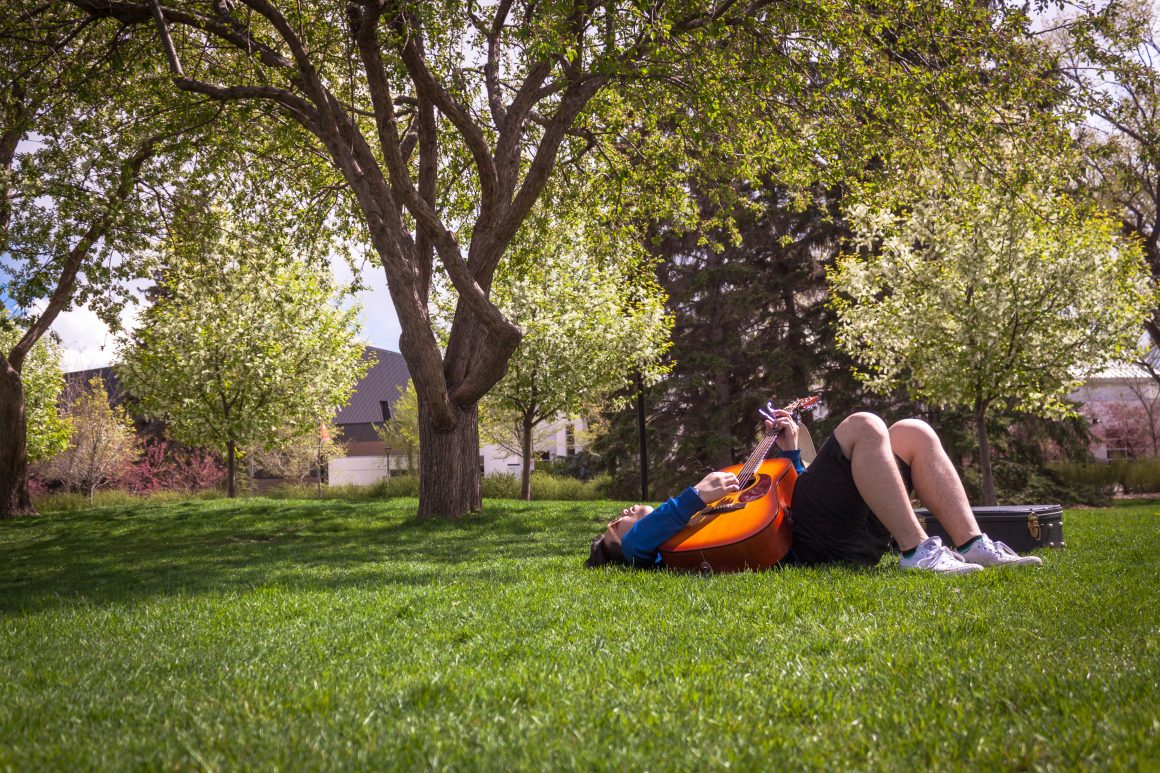
Combat stress and anxiety with grounding techniques
By Christie Melhorn, October 11 2017 —
As a busy University of Calgary student, you’ve probably become accustomed to stress and anxiety, kind of like how you get used to the MacHall food court being a total shit-show at lunchtime. The relentless chatter, cash registers slamming and procrastinating students watching YouTube videos on full blast is metaphoric of your endlessly spinning thoughts. The way you put up with your numb spine from those backless cafeteria seats is similar to tolerating constant stress-tension in your body.
We often don’t realize how overwhelmed we are because we’re just used to it. This can lead to an intensified symptom of anxiety called dissociation. Anxiety Care United Kingdom defines dissociation, also known as depersonalization or derealization, as “a change in self-awareness” which involves a feeling of severed autonomy from your thoughts and actions.
Dissociation can occur at any time. It feels as though a mental fog is cast over your vision, alienating you from your surroundings. Objects appear two-dimensional and may appear to change in size and shape. It can also cause you to perceive other people as inanimate and, in extreme cases, instil a sense of impending death.
As dramatic and comical as it may sound, dissociation is visceral and convincing. I’ve experienced varying degrees of it most of my life but the most severe instance was on the day of my convocation from the University of Calgary this past June. The panic attack brewed during the entire ceremony but came to a boil afterwards. I was downtown and felt like I was in a sinister funhouse full of looming, warped mirrors. The buildings around me looked like wobbly paper cut-outs. Cars driving by seemed like they were melting or falling apart. My footing was unsteady and the voices of people around me were nonsensical.
Between sincerely believing that I was dying or needed to be hospitalized, I decided to surrender to the feeling and collapsed on the lawn of the Peter Lougheed House. Laying down with my eyes closed, I clutched a set of crystal beads I happened to be gifted earlier that day, finding comfort in their soft and smooth texture. I embraced the lush grass underneath of me and the occasional breeze that swept over my skin.
Without realizing, I was engaging in a coping mechanism known as grounding. Grounding roots you in the present and strengthens your mind-body connection. It involves both sensory and cognitive approaches. Sensory strategies are helpful to practice first as they can distract from mental chatter. Cognitive strategies untangle mental disorientation and bring clarity to your thinking process.
The following examples may seem simple and even childish. But they are incredibly effective and helped me peel off the Lougheed House lawn to carry on with my day. Some of these are my own invention and others are adapted from anxiety coping resources provided by the Calgary Counseling Centre and the Calgary Communities Against Sexual Abuse.
Sensory grounding strategies:
- Gently trace your facial features with your fingers. Start by tracing your orbital bones then go down the bridge of your nose and over your mouth. Take your fingers down your chin and then move along your jawline up to your ears, giving your lobes soft pinches.
- Choose a nearby object and hold it. Examine how it feels, looks, sounds and functions. This can be something as simple as a pencil. Try not to use your phone or laptop, as incoming messages or the presence of a stressful assignment or task buried somewhere in your screen can be counterproductive.
- Take out a pen and paper and trace your hand. Label each finger as one of the five senses and then describe a sensation you are experiencing in that moment that corresponds with each one. If you don’t have access to a pen and paper, use one of your hands to trace your fingers and verbally label them.
Cognitive grounding strategies:
- Write or verbalize basic details about yourself: your first and last name, age, height, hair color, eye color, gender, address and so on. You could expand to include the same information about friends or family members — this also helps remind you of your support network.
- Tell a story either orally or on paper. Revisit a fond memory and root yourself back into that moment. Shed any judgment about grammar, spelling, inflection, chronology of events or style. Describe the setting, the other people involved, any conversation that occurred and how you felt in that moment. Write down whatever comes into your head without disregarding particular details as insignificant. It doesn’t need to be a true event either — it can even be a scene from a book or movie or a dream you had.
There are a diverse range of helpful grounding activities that many students likely engage in without realizing it. Scrolling through Instagram or endlessly flickering through memes probably even counts. However, relying on our phones or social media for such comfort can be potentially triggering and doesn’t provide a holistic sensory-engagement experience.
Play around with different strategies to see what works for you. Just know that if you suffer from anxiety, stress or depression, you are not alone. Pretty much all of us have been there, whether we knew it or not. Click here to learn about anxiety-management resources on campus.
